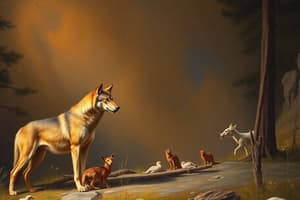Podcast
Questions and Answers
What is the primary relationship in mutualism?
What is the primary relationship in mutualism?
- One organism is harmed while the other benefits.
- Both organisms benefit from the interaction. (correct)
- One organism is unaffected while the other benefits.
- Neither organism gains any advantage.
Which of the following best describes commensalism?
Which of the following best describes commensalism?
- Both organisms benefit equally from the relationship.
- Both organisms involved are negatively impacted.
- One organism benefits and the other is unaffected. (correct)
- One organism primarily preys on the other.
In which scenario does parasitism occur?
In which scenario does parasitism occur?
- A fish obtains protection from a shark while eating leftovers.
- A barnacle attaches to a rock for nutrients.
- A bird gains food while a buffalo is cleaned.
- A leech feeds on the blood of a host organism. (correct)
What distinguishes herbivory from predation?
What distinguishes herbivory from predation?
Which example best represents the concept of mutualism?
Which example best represents the concept of mutualism?
What is the primary ecological role that wolves play in the Yellowstone ecosystem?
What is the primary ecological role that wolves play in the Yellowstone ecosystem?
What effect do wolves have on the populations of other species in the ecosystem?
What effect do wolves have on the populations of other species in the ecosystem?
How does the presence of wolves indirectly affect the health of rivers in Yellowstone?
How does the presence of wolves indirectly affect the health of rivers in Yellowstone?
What is a trophic cascade?
What is a trophic cascade?
Which species are positively affected by the presence of wolves in Yellowstone?
Which species are positively affected by the presence of wolves in Yellowstone?
What is the primary role of decomposers in an ecosystem?
What is the primary role of decomposers in an ecosystem?
Which of the following correctly defines a food chain?
Which of the following correctly defines a food chain?
Which statement about energy transfer in a trophic pyramid is accurate?
Which statement about energy transfer in a trophic pyramid is accurate?
What distinguishes herbivores from carnivores?
What distinguishes herbivores from carnivores?
In ecological terms, what is competition primarily focused on?
In ecological terms, what is competition primarily focused on?
Which statement correctly describes the role of autotrophs in an ecosystem?
Which statement correctly describes the role of autotrophs in an ecosystem?
What is the primary difference between food webs and food chains?
What is the primary difference between food webs and food chains?
Which of the following best defines 'biomass' in ecological studies?
Which of the following best defines 'biomass' in ecological studies?
Flashcards
Trophic Cascade
Trophic Cascade
A chain reaction that occurs in an ecosystem when one population changes in size, affecting the populations of other species in the food web.
Yellowstone example
Yellowstone example
A case study where wolves reintroduction changed river health and forest regeneration.
Food Web
Food Web
Complex feeding interactions among organisms in an ecosystem, illustrating multiple food chains.
Decomposers
Decomposers
Signup and view all the flashcards
Energy loss as heat
Energy loss as heat
Signup and view all the flashcards
Predation
Predation
Signup and view all the flashcards
Herbivory
Herbivory
Signup and view all the flashcards
Symbiosis
Symbiosis
Signup and view all the flashcards
Mutualism
Mutualism
Signup and view all the flashcards
Parasitism
Parasitism
Signup and view all the flashcards
Abiotic factor example
Abiotic factor example
Signup and view all the flashcards
Flow of energy in an ecosystem
Flow of energy in an ecosystem
Signup and view all the flashcards
Trophic levels
Trophic levels
Signup and view all the flashcards
Food chain
Food chain
Signup and view all the flashcards
Intraspecific competition
Intraspecific competition
Signup and view all the flashcards
Community
Community
Signup and view all the flashcards
Study Notes
Yellowstone Wolves Trophic Cascade
- Wolves, in Yellowstone, don't just kill; they also influence other species, leading to a cascade effect.
- Wolves control deer populations by limiting overgrazing, which stabilizes river banks and improves plant and wildlife populations.
- This demonstrates a trophic cascade, where the presence or absence of a top predator significantly impacts lower trophic levels.
- The effect on rivers demonstrates how wolves influence the regeneration of forests, which stabilizes riverbanks.
- Driving deer out of certain areas changes the soil, which leads to cascade effects throughout the river ecosystem.
Food Web Example
- The Yellowstone food web shows complex interactions among various species, including wolves, deer, beavers, and various plant species.
- The arrows represent the flow of energy as one organism consumes another.
Ecology Notes (11/22)
- Decomposers break matter down and return it to producers, releasing energy as heat.
Ecology Notes (12/2)
- Ecology examines biotic (living) and abiotic (non-living) factors in an environment, such as water, pH, terrain, and air.
- Energy flows from autotrophs (producers) to heterotrophs (consumers), ultimately losing energy.
- Consumers are categorized as herbivores (eat plants), carnivores (eat animals), omnivores (eat both plants and animals), or decomposers (decompose dead organic matter).
Ecology Notes (12/4)
- Communities are combinations of populations interacting.
- Competition occurs within and between species. Intraspecific competition occurs within the same species, while interspecific competition occurs between different species.
- Predation is where one organism eats another. Herbivory is a subset of predation involving consumption of plants.
- Symbiosis is a relationship between organisms. Mutualism is a type of symbiosis where both organisms benefit.
Types of Interactions
- Commensalism: One organism benefits, and the other is unaffected (e.g., birds cleaning buffalo).
- Parasitism: One organism benefits, and the other is harmed (e.g., barnacles on a whale, mistletoe on a tree).
Studying That Suits You
Use AI to generate personalized quizzes and flashcards to suit your learning preferences.




